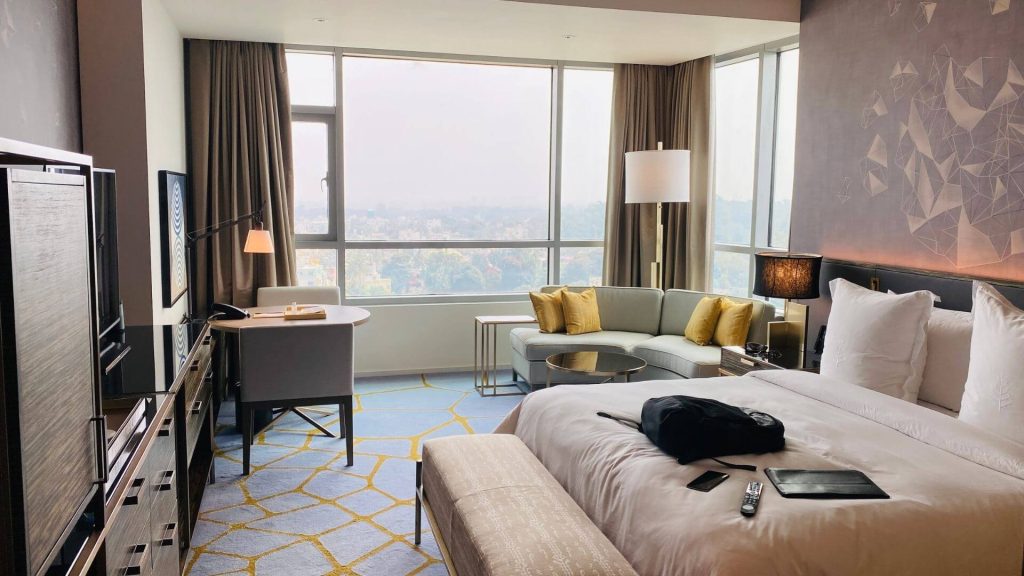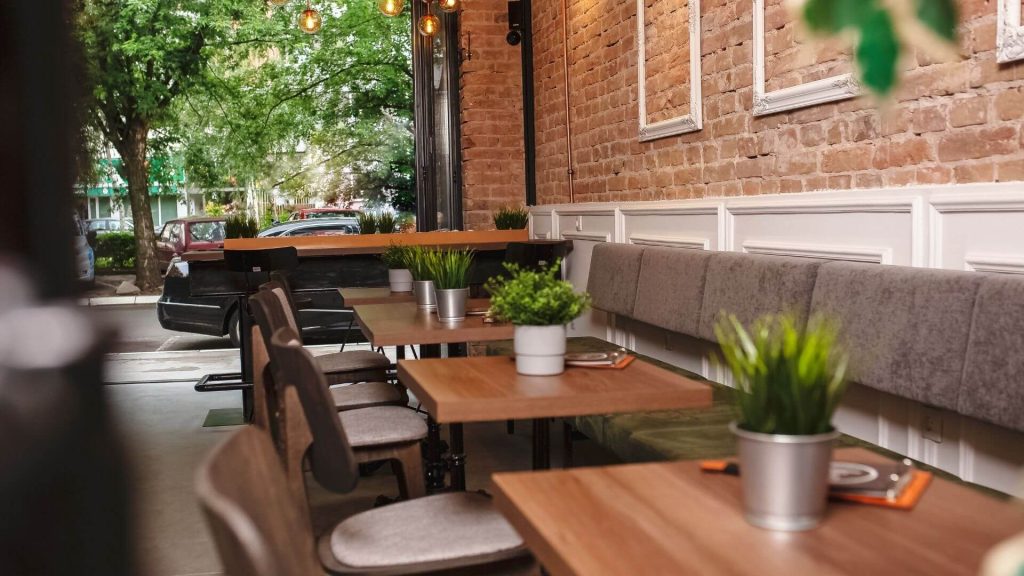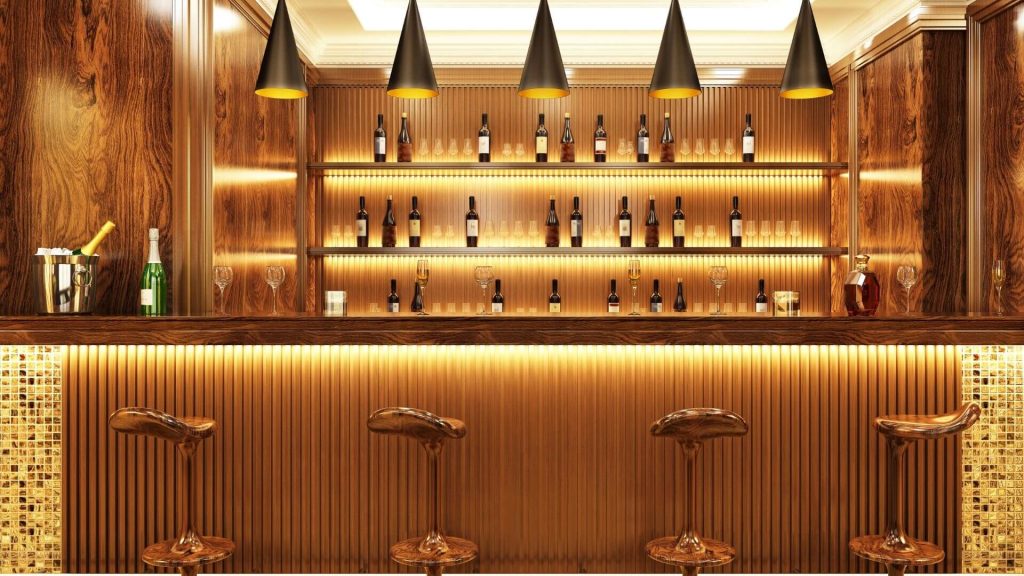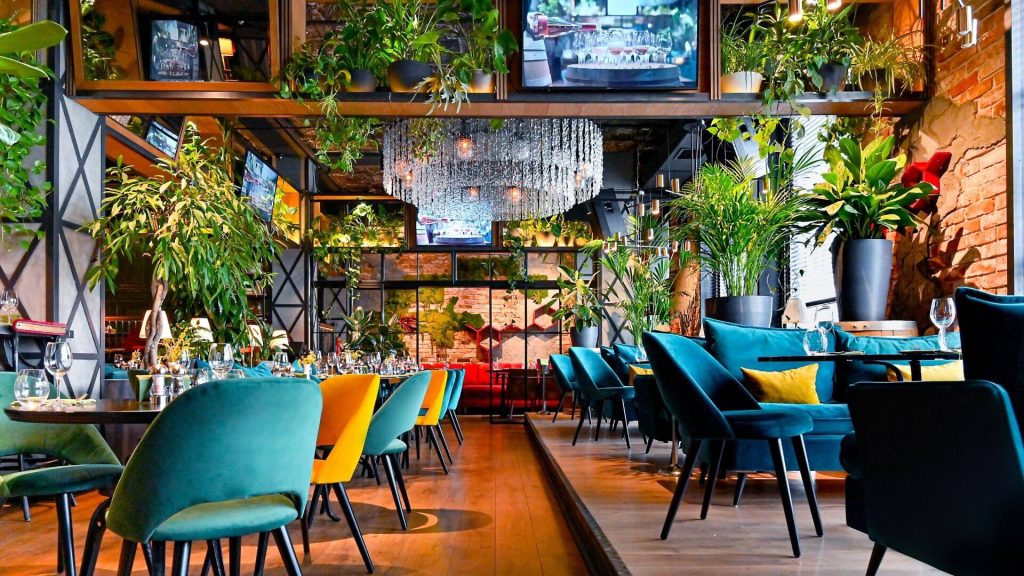Table Of Contents
In London’s competitive hospitality scene, creating an outstanding venue takes more than great food or service—it requires a comprehensive interior transformation. A hospitality fit-out encompasses everything needed to turn an empty or outdated space into a vibrant hotel, restaurant, bar, or café ready to welcome guests. It’s a holistic process covering design, construction, furnishings, and all the details in between. In this blog, we break down what’s included in a hospitality fit-out (with a focus on London), from the initial planning stages to the finishing touches. We’ll also look at specific considerations for hotels, restaurants, bars, and cafes, plus local London factors like regulations, trends, and sustainability. By understanding the full scope of a fit-out, business owners can better plan their projects and partner with the right contractor to bring their vision to life.
The Complete Hospitality Fit-Out Process
A hospitality fit-out is essentially the journey of preparing an interior space for customers and staff—from bare walls to a fully operational venue. This process includes everything from planning and design to the choosing and fitting of every interior element. In fact, every detail is considered: an oft-cited definition notes that “everything down from the wallpaper to the fork used by the customer” is carefully matched to the overall concept. In practical terms, this means a fit-out covers all construction and installation work needed to make the space functional and on-brand. It starts with layout planning and architectural adjustments (for example, putting up or removing walls to create the right flow of spaces). It involves structural elements like floors, ceilings, and partitions, which lay the groundwork for the venue’s look and ensure safety and durability. Electrical and plumbing systems are installed or upgraded to support lighting, climate control, kitchen equipment, restrooms, and other facilities. Every aspect of the interior, from bespoke furniture and lighting fixtures to décor and signage, is curated and built to align with the venue’s theme and purpose.
Crucially, the fit-out process also includes obtaining any necessary permits and adhering to building regulations (especially important in London, as we’ll discuss later). A professional fit-out contractor will manage project timelines, coordinate tradespeople (electricians, plumbers, joiners, etc.), and handle on-site supervision to ensure quality and safety. By providing comprehensive project management, they make sure that each stage—from initial strip-out of any old fittings to final install and finishing—runs smoothly and efficiently. The ultimate goal is to deliver a turn-key interior that not only looks impressive but also functions optimally for staff and guests. As hospitality consultants point out, a well-thought-out interior can greatly influence the guest experience and even encourage employees to deliver better service. Next, let’s explore how this general fit-out scope applies to different types of hospitality venues.
Hotel Fit-Outs: Creating a Home-Away-From-Home
Fitting out a hotel in London is a complex undertaking, covering a wide range of spaces and requirements. At the core is the guest accommodation: individual hotel rooms and suites must be crafted for comfort, aesthetics, and durability. This includes installing quality flooring (e.g. plush carpets for warmth or hardwood for elegance), wall finishes and ceilings that reflect the hotel’s design theme, and of course the furniture and fixtures that make the room usable. Beds, wardrobes, desks, lighting, and even the artwork are all selected or custom-made to fit the brand and layout. Attention to detail is paramount—for instance, ensuring a consistent style in everything from the headboard design to the color of the curtains. Crucially, behind the style there must be substance: walls and floors in hotels require proper sound insulation and fireproofing to guarantee guest privacy and safety. During the fit-out, features like fire-resistant doors, smoke alarms, and emergency lighting are integrated seamlessly into the design to meet UK fire safety regulations without compromising ambience.
Hotel fit-outs also encompass en-suite bathrooms and plumbing installations in each room. This involves installing bathroom fixtures (toilets, sinks, showers or tubs) along with adequate ventilation and waterproofing. The choice of materials here—tiles, sealed flooring, splash-proof paint—must marry luxury with longevity, since hotel bathrooms see constant use. Beyond the private rooms, extensive work goes into front-of-house areas: lobbies, reception desks, corridors, and amenities. In a London boutique hotel, for example, the lobby might be a showpiece of the fit-out, featuring a custom reception counter, stylish seating areas, bespoke lighting, and perhaps a bar or café corner for guests. All these elements are built or installed during the fit-out, transforming an empty shell into a welcoming entrance that gives guests their first impression. If the hotel offers facilities like restaurants, bars, gyms, or spas, those too are part of the fit-out scope (often essentially mini-projects of their own, with specialized requirements we’ll touch on later). Even back-of-house areas – staff offices, kitchens, laundry rooms, etc. – are fitted out with the necessary equipment and finishes so that the hotel can operate smoothly behind the scenes.

Throughout a hotel fit-out, functionality must balance with luxury. Guests might not see the wiring, air-conditioning ducts, or pipework, but these systems are carefully installed during the fit-out to ensure every room has reliable utilities and climate control. Modern hotels also integrate technology as part of the interior: keycard systems, smart room controls, Wi-Fi and entertainment systems all require infrastructure laid in the fit-out phase (cabling, server rooms, access points discreetly placed in ceilings and walls). Additionally, accessibility is key: the fit-out will include features to comply with the Equality Act, such as installing lifts (or ensuring access to rooms via ramps), designing a number of rooms to be wheelchair-accessible, and fitting appropriate grab rails and alarm systems. By the end of the project, a hotel fit-out delivers a cohesive environment where every element—from structural fittings to decorative flourishes—works in harmony to create a memorable guest experience. It’s about providing that “home-away-from-home” feeling with the comforts of good design and the assurances of safety and quality.
Restaurant Fit-Outs: Balancing Ambiance and Function
Restaurants in London range from chic fine-dining establishments to cozy cafés and trendy pop-ups, but all share a need for a well-planned fit-out. A restaurant fit-out typically begins with shaping the layout of the dining area and kitchen to optimize both customer experience and operational efficiency. Often, this means constructing or moving partition walls to create the right sized dining room, installing service doors to separate kitchen and dining spaces, and laying down durable, easy-to-clean flooring (for example, high-quality tiles or hardwood in dining areas, and safety vinyl in kitchens). The ceilings and walls are finished in line with the restaurant’s theme—whether that’s an industrial exposed-brick look or a refined painted ambience—with careful thought given to acoustics (nobody enjoys shouting over dinner in an echoey room) and lighting. In fact, lighting design is a big part of restaurant fit-outs: contractors install a mix of ambient lighting, task lighting (like focused light over tables or the bar), and accent lighting to create the desired mood for day and night. All the electrical wiring for these, as well as for music systems or digital menu boards, is handled during the fit-out phase.
Furnishings and fixtures in the dining area are another major component. The fit-out covers the sourcing or custom-building of the restaurant’s furniture: chairs, tables, banquettes or booths, barstools, and so on. These not only need to match the interior design style, but also must be commercial-grade for heavy use. Often, specialist joinery is done to create built-in seating, paneling, or bar counters that perfectly fit the space. A typical restaurant fit-out will also include installing the service counters or bar where staff prepare drinks or handle payments, ensuring they have built-in storage, fridges, sinks, and any needed equipment. In London, many restaurants have compact footprints, so the fit-out involves clever space planning—perhaps building a mezzanine level for extra seating or creating multifunctional furniture that can be reconfigured as needed. Don’t forget the smaller yet essential elements: restrooms are fitted out with appropriate flooring, tiles, sanitaryware, and ventilation, and often a touch of décor to keep the style consistent throughout the venue. If the establishment has a front reception or waiting area, that too is crafted during the fit-out (with features like a hostess stand, waiting bench, coat storage, etc.). In short, the front-of-house of a restaurant fit-out covers everything the customer will see and use—from the floor they walk on to the light fixtures above and the cutlery on the table.

Equally crucial is the back-of-house aspect of a restaurant fit-out, primarily the kitchen. London restaurants must adhere to strict food hygiene and safety standards, so the kitchen installation is a specialist undertaking. The fit-out team will work with kitchen designers or catering equipment suppliers to install ventilation hoods and ductwork (to extract cooking fumes safely), commercial-grade cooking appliances, refrigeration units, prep stations, and dishwashing areas. Surfaces in the kitchen need to be stainless steel or other hygienic, easy-clean materials as required by regulations. The plumbing has to accommodate multiple sinks (for food prep, handwashing, dishwashing) and often grease traps to protect the building’s drainage. Electrical systems are put in place to power high-load kitchen equipment and maintain safety (with proper circuit breakers and possibly gas interlock systems that comply with UK codes). During the restaurant fit-out, contractors also ensure that fire safety is built in – for example, installing fire-resistant wall panels in the kitchen, emergency gas shut-off valves, and fire suppression systems over cooking ranges if needed. All these technical installations happen behind the scenes, but are absolutely part of “what’s included” in a full restaurant fit-out. By the end of the process, the restaurant space is turnkey: furniture set, kitchen ready for chefs, ambience set to delight customers. Whether it’s a quaint café or a high-end London eatery, a proper fit-out balances ambiance and function, creating a dining environment that looks inviting, meets all health and safety requirements, and allows staff to deliver great service efficiently.
(Notably, even in a “basic” hospitality fit-out, you can expect all the fundamental elements to be covered. For example, one fit-out firm explains that a standard restaurant project will include flooring, furniture, service counters, front-of-house décor as well as back-of-house kitchen setup, plus essentials like restrooms and a bar or reception area if needed. In other words, nothing critical is left out.)
Bar and Pub Fit-Outs: Crafting the Perfect Atmosphere
London’s bars and pubs are as diverse as its neighborhoods—from traditional wood-paneled pubs to swanky cocktail lounges—and a fit-out for these spaces is all about setting the right atmosphere while ensuring practicality. A bar fit-out typically centers on the main bar counter area, which is often custom-built as part of the project. This involves constructing the bar itself (with sturdy materials like hardwood, metal, or stone for the countertop) and integrating all the necessary equipment: beer taps and lines, refrigerators for bottles and kegs, glass racks, sinks, ice wells, and sometimes specialty gear like cocktail stations or coffee machines. The under-bar plumbing and electrical wiring are carefully fitted so that bartenders have everything at their fingertips without visible clutter. Storage and display are key here too—the fit-out will include shelving or display cases for liquor bottles, which often become a design feature in their own right (think of an illuminated back-bar showcasing rows of spirits). The layout must facilitate quick service, so fit-out experts plan the spacing behind the bar for staff to move efficiently, and include features like speed rails and drip trays built into the counter.

Beyond the bar itself, the customer area in a pub or bar requires a distinct design approach. The fit-out will install appropriate flooring (for example, durable hardwood or tiles that can handle spills and high foot traffic) and often includes constructing raised platforms or distinct seating nooks to create different zones within the venue. Lighting plays a starring role in bar interiors: many modern bars incorporate creative lighting schemes – from dimmable warm lights for a relaxed mood to color-changing LEDs or neon accents for a more vibrant energy. In fact, current design trends show bars becoming increasingly immersive; dramatic lighting and stunning decorative backdrops are used to transport patrons into a different “drinking dimension,” creating a visually striking experience. During the fit-out, such features are installed with precision, including any audiovisual systems (like a DJ booth, speakers, or TVs for sports pubs) and special effects lighting if it’s a club-like venue. Acoustics are another consideration: fit-out specialists may add acoustic panels or soundproofing, especially in London where many bars need to contain noise to respect nearby residents and comply with licensing conditions.
Seating and furniture in a bar fit-out are chosen for both style and toughness. From high stools at the bar to upholstered sofas in lounge areas or standing drink ledges, all are integrated into the design. The fit-out team will often custom-make benches or fixed seating to maximize space usage. Safety and crowd flow are crucial factors addressed during a bar fit-out. This means ensuring there are clear pathways and sufficient exits (with lit exit signs and emergency lighting installed) for busy nights, and that materials used are fire-retardant where appropriate. Many pubs in London occupy older or historic buildings, and a skilled fit-out will work to retain any charming original features (like exposed beams or antique bars) while upgrading the infrastructure to modern standards. For example, an Edwardian pub might keep its iconic bar front, but the contractors will refurbish it and reinforce it, as well as discreetly run new wiring and beer lines through it. In summary, a bar fit-out includes everything from the tangible (the bar counter, seating, lighting, décor) to the intangible (the mood and character of the space). By the end of the process, the establishment should not only be fully equipped to serve drinks efficiently, but also exude a distinct atmosphere—be it cosy, chic, or electrifying—that keeps patrons coming back for another round.
Café Fit-Outs: Comfort and Brand Character in Small Spaces
Cafés and coffee shops might be smaller in scale than hotels or restaurants, but a café fit-out is no less detailed. In fact, packing all the necessary elements into a often limited floor area requires smart planning and creative design. A typical café fit-out in London will start by configuring the customer flow and service counter. This usually means designing a clear path from the entrance to the order counter and then to seating areas. The fit-out may involve building a compact counter that houses display cases for pastries, an embedded point-of-sale system, under-counter refrigerators, and high-end coffee machines. These machines (espresso makers, grinders, blenders) have specific electrical and plumbing needs—so during the fit-out, water lines and filtration systems are installed to feed the coffee machines, and special 20A electrical circuits might be added to handle their power load. The counter surface and back counter are fitted with materials that resist heat and are easy to clean, like stainless steel or stone, given the constant use and the need for hygiene.
Seating is a focal point of café interiors, contributing both to functionality and brand character. The fit-out process will bring in a mix of furniture: perhaps some cosy armchairs or banquettes for patrons who want to linger, plus smaller tables and chairs for quick bites or laptop work. In tight London spaces, custom joinery can create bench seating along walls or in window nooks to use every inch efficiently. Interior finishes in a café often aim for a warm, inviting vibe—think wooden flooring or high-quality laminates, calming color schemes, and decorative touches that reflect the café’s identity. Whether it’s a minimalist modern coffee bar or a quirky indie café with eclectic decor, all those design elements (wall art, shelving, menu boards, plants, lighting fixtures) are installed during the fit-out. Lighting in cafés tends to prioritize brightness and comfort: large windows are often a feature (so window refurbishment might be part of the fit-out), supplemented by pendant lights or sconces that create a pleasant ambiance for the morning coffee rush and the afternoon laptop crowd alike.

Even in a small cafe, back-of-house and compliance factors are vital parts of the fit-out. This includes fitting a tiny kitchen or prep area if food is served (with at least a sink, refrigeration, and possibly an oven or stovetop, all requiring proper ventilation and power). Storage is often at a premium, so the fit-out will integrate storage cabinets or even build a mezzanine or use cellar space for storing stock and supplies. Because cafés serve food and drink, they must meet health and safety standards just like restaurants: the fit-out will ensure easy-to-clean surfaces, pest-proofing where needed, and adherence to fire safety (for instance, installing a fire extinguisher and alarm near the cooking area, emergency exit signs, etc.). Accessibility is another London requirement—the fit-out should provide step-free entry or a ramp if there’s a small door threshold, and ideally an accessible WC if space permits, so that all customers can be accommodated. Many cafes also cater to a takeaway clientele; as such, the fit-out might include designing a convenient pick-up station or an efficient queueing area. Lastly, a cafe fit-out in a city like London may extend outdoors: fitting out an exterior seating terrace with sturdy outdoor furniture, awnings or heaters (subject to local council permissions) is often part of the package to maximize seating. By the end of a café fit-out, the venue should feel true to its brand—be it artisan chic, homely and rustic, or sleek and urban—while functioning effortlessly for both baristas and customers. It’s a small space made perfectly formed, where every piece has its place.
Complying with London Building Regulations and Planning
One of the defining aspects of any fit-out in London is navigating the city’s building regulations and planning requirements. When you undertake a hospitality fit-out here, you’re not just installing pretty furnishings—you’re also legally obliged to meet UK building standards for safety, accessibility, and health. This is a comprehensive topic, but in essence, all the work done during a fit-out must comply with building regulations (the UK’s Building Regulations 2010 and subsequent updates) covering everything from structural integrity to fire safety to energy efficiency. For example, if as part of a restaurant fit-out you remove a load-bearing wall to open up space, you must insert proper supports (like steel beams) and possibly get approval from a structural engineer; building control will need to sign off that alteration as safe. Similarly, adding new plumbing, electrical circuits, or ventilation systems triggers compliance checks to ensure they meet standards. In practice, a competent fit-out contractor will manage this by submitting building control applications on your behalf and scheduling inspections at key stages. At project completion, you should receive a completion certificate from the local authority or approved inspector, confirming the fit-out work meets all requirements.
Planning permission is another consideration, though it’s not always required for interior fit-outs. In many cases, if you are simply refurbishing an existing restaurant or updating a hotel interior without altering the building’s external appearance or its permitted use, you may not need full planning permission. However, there are important scenarios where you do. If your fit-out plans involve a “material change of use” of the property—say you are converting a retail shop into a café or turning a pub into a restaurant—then you will likely need planning permission for that change. The local council will review factors like noise, ventilation (for cooking fumes), and the impact on the area before granting approval. Also, any significant external changes (for instance, installing a new shopfront for your bar, adding a rooftop terrace to your hotel, or putting up new signage beyond a certain size) typically require planning consent. In central London, hospitality entrepreneurs often face these planning steps due to the dense urban environment and mixed-use neighborhoods. Obtaining permission involves submitting detailed plans and sometimes local consultation, which can add time to your project—so it’s wise to factor this in early.
London’s rich history means many hospitality venues are in listed buildings or conservation areas, which adds another layer of permission needed. If your restaurant or hotel is in a listed building, the fit-out must be done very sensitively, preserving historic features. Any alteration to the character of a listed building (down to seemingly small details like changing internal mouldings or light fittings) might require Listed Building Consent from the council. Similarly, properties in conservation areas may have restrictions on things like signage illumination or alterations visible from outside. The good news is that a seasoned London fit-out company will be familiar with these requirements. We guide our clients through the approvals process and often handle the paperwork, liaising with architects and authorities to secure the necessary consents. It’s part of what’s “included” when you choose a full-service fit-out partner: not only do we build out your venue, but we also make sure it’s legally compliant to open for business.
Finally, safety certifications and inspections are an inherent part of the fit-out wrap-up. In a hospitality setting, this means ensuring fire safety measures are in place and checked (fire alarms, extinguishers, emergency exits, smoke ventilation systems if required). Fire risk assessments must be updated for the new layout and submitted to authorities. Electrical installations will be tested and certified to NICEIC standards, and gas appliances (like in a commercial kitchen or heating system) will be installed by Gas Safe engineers and certified. All these compliance steps might sound onerous, but they are crucial for legal operation and, most importantly, for the safety of your staff and patrons. London authorities conduct strict oversight, but by building regulation compliance into the fit-out plan from the start, there should be no unwelcome surprises. In short, a hospitality fit-out in London isn’t just about looking amazing—it’s also about building it right, in line with all regulations, so you can open your doors with confidence.
Trends in London’s Hospitality Interiors
Design and functionality in hospitality are always evolving, and London is often at the forefront of new trends. When planning a fit-out, it pays to be aware of the current directions in hospitality interior design—both to meet customer expectations and to future-proof your investment. One noticeable trend is the emphasis on creating unique, experience-led spaces. Standard, formulaic interiors are out; today’s hotels, restaurants and bars strive to offer something distinctive and Instagram-worthy. For instance, many London boutique hotels and bars are incorporating bold, locally inspired artwork, themed decor, and immersive lighting installations. At recent industry events like the Independent Hotel Show, experts highlighted nature-inspired decor, a heightened sense of comfort, and versatile use of space as key themes for 2024’s hospitality design. This might translate into features such as indoor plants and green walls (bringing a touch of biophilia and calm into urban spaces), plush and homely furnishings that make guests feel at ease, and layouts that can flex for different uses (a hotel lobby that doubles as a co-working space, for example). A fit-out can embrace these trends by using materials and layouts that create a certain mood—whether it’s calming and organic or vibrant and social—tailored to what your target clientele appreciates.
Another trend is the blending of old and new, which is very relevant in London where contemporary venues often sit inside historic buildings. We see heritage features being preserved and highlighted as part of the interior design (exposed brick, vintage beams, or Victorian tiles), juxtaposed with modern luxury elements. This creates a layered look that tells a story—something guests increasingly seek out. In restaurant and bar fit-outs, there’s a clear move towards making the environment part of the entertainment. Open kitchens in restaurants are one example, turning meal preparation into a visual experience for diners. Likewise, bars are upping the drama quotient: custom cocktail bars with theatrical lighting, reflective surfaces, and artistic backdrops are becoming common in high-end venues. The goal is to make the interior so intriguing that it’s a talking point in itself. Dramatic lighting and statement pieces can transform a bar into a destination, and many new fit-outs include features like neon art signs, projection screens, or even interactive elements (such as digital displays that can change with the mood or time of day).
London’s hospitality design is also heavily influenced by the lifestyle and tech changes of our time. Post-pandemic, for example, flexibility and safety have become part of design thinking. Venues now often plan for more spacious layouts or adaptable furniture arrangements to accommodate private dining or distanced seating when needed. The integration of technology is another big trend: hotels installing smart-room controls, restaurants using digital ordering systems or QR code menus, and cafes offering plenty of charging points and ultra-fast Wi-Fi. A modern fit-out will include the infrastructure for these, such as extra power outlets, data cabling, and discreet mounting spots for screens or projectors. There’s also a trend toward inclusive design – ensuring spaces are accessible and comfortable for all ages and abilities – which ties in with both regulatory compliance and good customer service. On the stylistic front, certain looks are trending in London interiors: for example, a rise of “residential warmth” in hotels (making hotel rooms feel like stylish apartments rather than sterile units), or the continued popularity of industrial-chic in many city eateries (with exposed ductwork and Edison bulb lighting, which the fit-out deliberately leaves visible as part of the design). Of course, trends come and go, so the best approach is to incorporate those that align with your brand and have some lasting power. A seasoned fit-out team can advise on materials and design choices that nod to current trends yet will still look fresh in years to come. Ultimately, London’s hospitality venues thrive by offering environments that are not just serviceable, but memorable, and a thoughtful fit-out is how those cutting-edge design ideas come to life on the premises.
Sustainability and Energy Efficiency in Hospitality Fit-Outs
No discussion of modern hospitality fit-outs would be complete without addressing sustainability. In recent years, sustainable design has shifted from a niche consideration to a core component of hospitality projects. London in particular has ambitious environmental targets, and hotels, restaurants, and bars are increasingly expected to minimize their carbon footprint. So what does sustainability mean in the context of a fit-out? It means making conscious choices at every step: selecting eco-friendly materials, implementing energy-efficient systems, and designing for longevity and low waste. For example, a fit-out might use responsibly sourced timber for bespoke furniture (with FSC-certified wood), low-VOC paints and finishes to ensure healthy indoor air, and recycled or upcycled materials where possible (such as repurposed wood from old buildings turned into a bar countertop). These choices reduce the environmental impact of the construction phase and often give the interior a unique character. Importantly, sustainability also extends to the operational side of the venue: integrating energy-efficient lighting, heating, and ventilation during the fit-out can dramatically cut energy usage once the venue is running. It’s common now to install LED lighting throughout, smart HVAC systems that adapt to usage and weather, and high-efficiency kitchen appliances or boilers. Such measures not only shrink the carbon footprint, but also offer significant cost savings on energy bills over time. In fact, embracing energy efficiency and sustainable practices is described as a win-win for hospitality businesses: it helps the planet while also improving the bottom line through lower operating costs.
Sustainability in hospitality fit-outs also involves thinking about water and waste. Many London hotels and restaurants are fitting water-saving devices (like low-flow taps, dual-flush toilets) and smart water management systems to avoid waste. During the build itself, a responsible contractor will aim to minimize construction waste and recycle materials—London’s regulations and good practice demand careful waste management plans for any big project. There is also a move towards designing for durability and adaptability. High-quality materials that last longer means less frequent refits (hence less waste over time), and flexible design means a space can be updated or repurposed with minimal new work. For instance, using modular furniture or removable partitions in a café can allow it to reconfigure or refresh its look without a complete teardown. Some venues are even pursuing green building certifications (like BREEAM or LEED) which guide the fit-out towards meeting certain sustainability benchmarks in energy, water, materials, and wellbeing criteria.
Crucially, today’s consumers are increasingly eco-conscious and notice these efforts. Travelers actively seek out green accommodations, and diners appreciate knowing their favourite restaurant is reducing its environmental impact. Industry research shows that venues that prioritize sustainability attract environmentally conscious guests and meet a growing demand for green hospitality options. In light of this, a hospitality fit-out will often include visible green features that become part of the guest experience – for example, a living plant wall in a hotel lobby that naturally improves air quality, or the use of reclaimed decor pieces that guests find charming and authentic to the brand story. Sustainability isn’t just a regulatory box to tick; it’s now a design ethos that can enhance the ambiance and narrative of your space. London authorities, too, encourage sustainable development – from providing grants for energy efficiency upgrades to imposing stricter energy requirements for new constructions under the London Plan. So by building sustainability into your fit-out, you’re aligning with both customer expectations and regulatory trends. In sum, a modern hospitality fit-out in London will strive to blend style with sustainability, ensuring that your venue is not only beautiful and functional, but also part of a greener future for the city.
Partnering for Success in Your London Hospitality Fit-Out
Embarking on a hospitality fit-out in London is a significant project, but with the right partner it can be an exciting and rewarding journey. As we’ve seen, a lot is included in a hospitality fit-out: from the big-picture design concept down to the smallest fixtures, from compliance paperwork to cutting-edge tech integration. It’s a multifaceted process that transforms four walls into a thriving customer space, ready to deliver exceptional experiences. Given the complexity, choosing an experienced fit-out specialist is just as important as choosing the right location or menu. A capable contractor will ensure that no aspect is overlooked – coordinating designers, builders, and engineers to bring your vision to life on time and on budget, all while navigating London’s regulatory landscape. At SEI, we pride ourselves on doing exactly that. We’ve delivered tailored hospitality interiors across London, from boutique hotel refurbishments to contemporary restaurant and bar makeovers, always with a focus on quality craftsmanship and seamless project management. Our corporate yet approachable style means we collaborate closely with you, the client, keeping your business objectives and brand identity front and center throughout the fit-out.
In the end, what’s included in a hospitality fit-out is everything your venue needs to open its doors and impress your guests from day one. By covering design, build, installation and compliance, a professional fit-out company takes the heavy lifting off your plate so you can focus on the bigger picture of running your business. Whether you’re aiming to elevate a hotel’s luxury factor, create an unforgettable theme for your restaurant, imbue your bar with an atmospheric vibe, or set up a cosy café nook in the heart of London, the fit-out will be the vehicle that drives those goals into reality. It’s a substantial investment, but one that yields a space capable of delighting customers and growing your revenue for years to come. If you’re considering a hospitality fit-out in London, we invite you to reach out and tap into our expertise. We’re here to answer your questions, guide you through local requirements, and ultimately, help design and build a venue that truly stands out in London’s vibrant hospitality scene.



